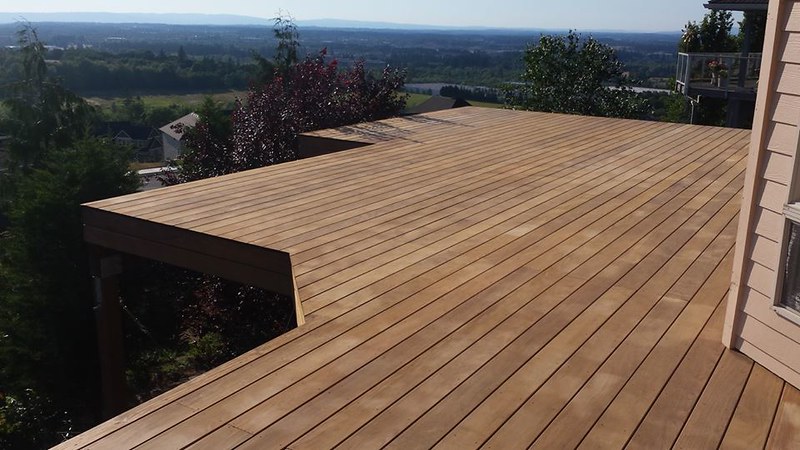Is Ipe Wood Sustainable?
Premium outdoor living areas enhance your indoor and outdoor garden space and the aesthetics of your home. Ipe (pronounced E-pay) can provide a touch of natural elegance to your garden and living spaces. Whether replacing your outdoor furniture or building a new deck, selecting the best material can be daunting. If you’re struggling with this decision, read on to explore the sustainability, characteristics, and advantages of using long-lasting Ipe wood.
What is Ipe Wood?

Ipe deck by Cascade Fence and Deck is licensed with CC BY-ND 2.0
Ipe wood comes from the Tabebuia tree and is one of the hardest woods in the world. It originates from the subtropical regions of Central and South America, and the trees produce pretty pink, red, or golden-yellow flowers. This exotic hardwood is often called Ironwood, Greenheart, Lapacho Negro, or Brazilian Walnut. Commercial and domestic uses for Ipe wood include decks, outdoor furniture, gazebos , planters, trellises, pergolas , fencing, siding , boardwalks, piers, and more. No two pieces of Ipe wood are alike, and the variety of color, graining, and figuration can make Ipe the perfect choice for an appealing backyard upgrade.
Is Ipe Wood Sustainable?
Ipe wood is sustainable because it is long-lasting and durable. High density and extreme hardness allow Ipe to last for decades, even in bad weather. Fire, insect, decay, and scratch resistance are a few natural properties of Ipe. It also has an inherent resistance to cracking, cupping, and splintering. Carbon stored in wood, even in the forest, will release back into the atmosphere when it decays. Therefore, Ipe decking or furniture’s long-lasting nature can be a sustainable way of keeping carbon out of the atmosphere. You can continue to impact carbon storage in the environment when you up-cycle Ipe.
The key to sustainable buying of Ipe wood is to confirm a vendor’s environment-friendly certification . A Forest Stewardship Council certification ensures that Ipe wood is from well-managed forests that provide environmental, social, and economic benefits. Sustainable forest management ensures that there are as many mature trees at the end of a harvest cycle as at the beginning. Property developers, builders, furniture manufacturers, and homeowners can feel confident about using Ipe wood, classified as a green material, for their projects. It is the most recognized hardwood internationally.
Characteristics of Ipe Wood
Here are some of the unique characteristics of Ipe that make it the ideal hardwood choice for a wide variety of outdoor structures and home improvement projects:
Long-lasting
The high density of Ipe wood makes it long-lasting and sturdy. This remarkable hardwood contains natural oils which preserve it for decades. Ipe can last longer than 25 years in harsh outdoor environments and up to 50 years if maintained . Most hardwoods do not expand and contract like Ipe, which makes this wood an even more adaptive material in any climate. Ipe wood can be one of the lowest-cost outdoor materials in terms of total lifetime value per year.
Durable
Ipe wood is durable because it is very dense and tight-grained, which gives this fine-looking hardwood its strength. Natural oils and tannins in the wood ensure its resistance to insects, especially termites. It is also resistant to rot and decay, like mold and fungus. These qualities make Ipe wood popular for outdoor home improvement projects, especially decking, fences, and outdoor furniture.
Hard
A Janka hardness scale measures and compares materials based on their hardness. Most reliable sources place Ipe in the top 10 of the hardest woods. Ipe wood is almost three times harder than white oak, five times harder than pressure-treated cedar, and has unparalleled resistance to scratching, splintering, and gouging. Its incredible hardness and strength make it well-suited for flooring applications like decks, boardwalks, and piers.
Advantages of Using Ipe Wood
Here are a few of the advantages of using Ipe wood for your next project:
Color Choice and Finish
Ipe wood displays a wide range of colors and natural beauty. It can vary in color from red-brown to more olive-brown and even a darker black-brown. The wood grains displayed in Ipe are wavy and straight with a fine smooth texture. Unlike other woods, Ipe doesn’t contain many knots. This wood’s exotic character marks and wide selection of colors make it a popular hardwood to decorate inside or outside your home.
Low Maintenance
Ipe wood is easy to maintain and resilient to the forces of nature, making it the most preferred material for home improvement projects and outdoor structures. The best way to protect Ipe wood is with an oil-based penetrating sealer. You can permanently remove debris with a leaf blower and clean it with water and mild soap to maintain its natural appeal. Ipe wood ages gracefully to a mellow silver patina that lasts a long time. Although Ipe is a low-maintenance hardwood and can last for decades, refinishing the structure is advisable after a considerable period.
Fire Resistance
The natural fire resistance of Ipe wood makes it a superb choice for siding and decking near fire pits, chimneys, outdoor fireplaces, and charcoal grills. Ipe wood has a class A fire rating, as do steel and concrete. A fence made of high-density Ipe wood can slow the spread of a fire and help keep it contained. Ipe decks and boardwalks never get too hot to walk on, as they don’t absorb and store the heat.
We hope this gave you a better understanding of the unique qualities and sustainability of using Ipe wood. If you have any further questions or want to know more about maintaining and restoring Ipe, contact us and set up a consultation. Our team of professionals is ready to help.
